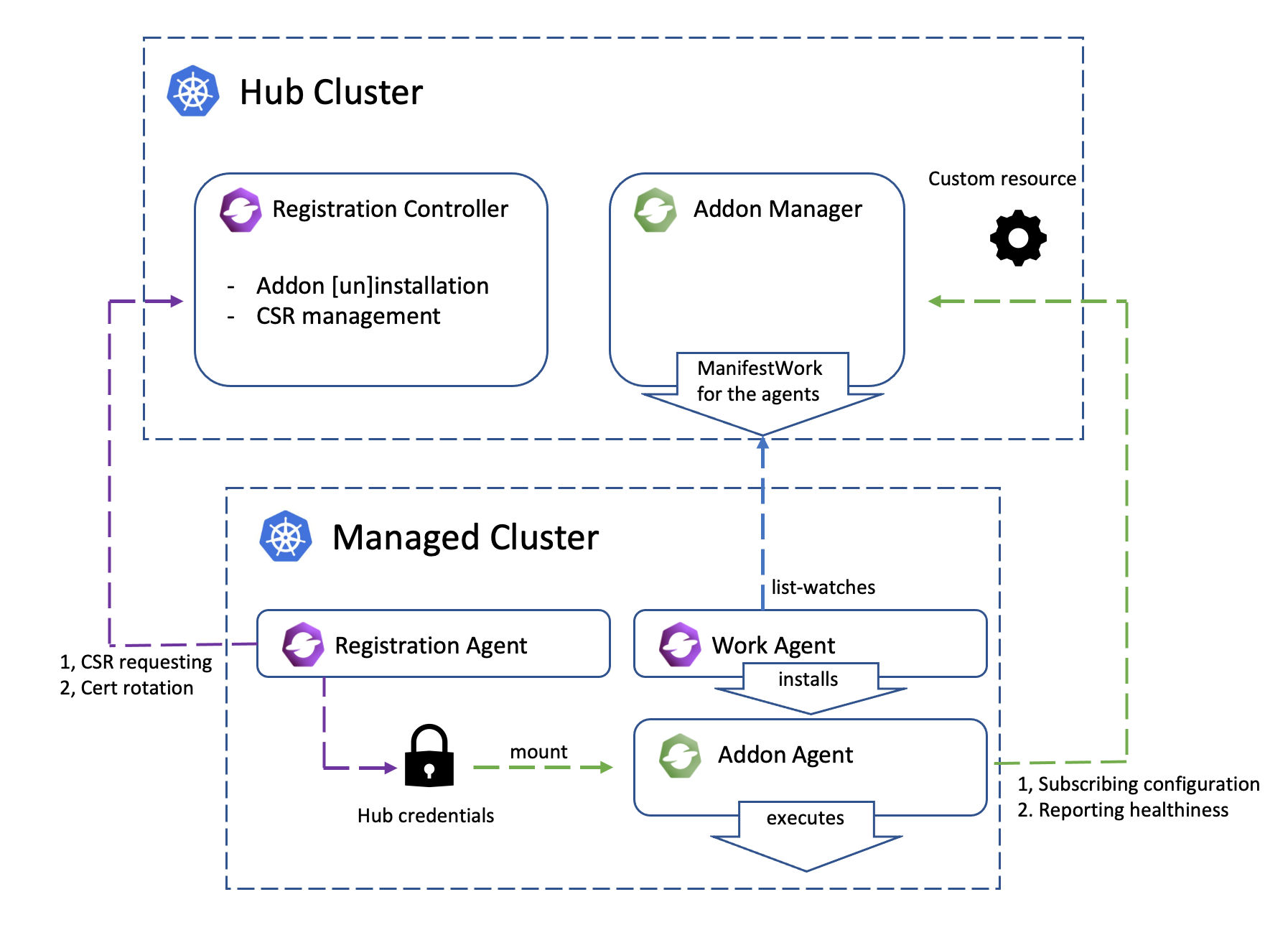Add-ons
What is an add-on?
Open-cluster-management has a built-in mechanism named addon-framework to help developers to develop an extension based on the foundation components for the purpose of working with multiple clusters in custom cases. A typical addon should consist of two kinds of components:
-
Addon Agent: A kubernetes controller in the managed cluster that manages the managed cluster for the hub admins. A typical addon agent is expected to be working by subscribing the prescriptions (e.g. in forms of CustomResources) from the hub cluster and then consistently reconcile the state of the managed cluster like an ordinary kubernetes operator does.
-
Addon Manager: A kubernetes controller in the hub cluster that applies manifests to the managed clusters via the ManifestWork api. In addition to resource dispatching, the manager can optionally manage the lifecycle of CSRs for the addon agents or even the RBAC permission bond to the CSRs’ requesting identity.
In general, if a management tool working inside the managed cluster needs to discriminate configuration for each managed cluster, it will be helpful to model its implementation as a working addon agent. The configurations for each agent are supposed to be persisted in the hub cluster, so the hub admin will be able to prescribe the agent to do its job in a declarative way. In abstraction, via the addon we will be decoupling a multi-cluster control plane into (1) strategy dispatching and (2) execution. The addon manager doesn’t actually apply any changes directly to the managed cluster, instead it just places its prescription to a dedicated namespace allocated for the accepted managed cluster. Then the addon agent pulls the prescriptions consistently and does the execution.
In addition to dispatching configurations before the agents, the addon manager will be automatically doing some fiddly preparation before the agent bootstraps, such as:
- CSR applying, approving and signing.
- Injecting and managing client credentials used by agents to access the hub cluster.
- The RBAC permission for the agents both in the hub cluster or the managed cluster.
- Installing strategy.
Architecture
The following architecture graph shows how the coordination between addon manager and addon agent works.

Add-on lifecycle management
Add-on lifecycle management refers to how to enable and disable an add-on on a managed cluster, how to set the add-on installation strategy and rollout strategy.
Please refer to the Add-on management for more details.
Install strategy
InstallStrategy represents that related ManagedClusterAddOns should be installed on certain clusters.
Rollout strategy
With the rollout strategy defined in the ClusterManagementAddOn API, users can
control the upgrade behavior of the addon when there are changes in the configurations.
Add-on configurations
Add-on configurations allow users to customize the behavior of add-ons across managed clusters. They include default configurations applicable to all clusters, specific configurations defined per install strategy for groups of clusters, and individual configurations for each managed cluster. This flexibility ensures that each cluster can be tailored to meet its unique requirements while maintaining a consistent management framework.
Please refer to the Add-on management for more details.
Examples
All available Add-Ons are listed in the Add-ons and Integrations section.
The addon-contrib repository hosts a collection of Open Cluster Management (OCM) addons for staging and testing Proof of Concept (PoC) purposes.
Add-on Development
Add-on framework provides a library for developers to develop an add-ons in open-cluster-management more easily.
Please refer to the add-on development guide for more details.